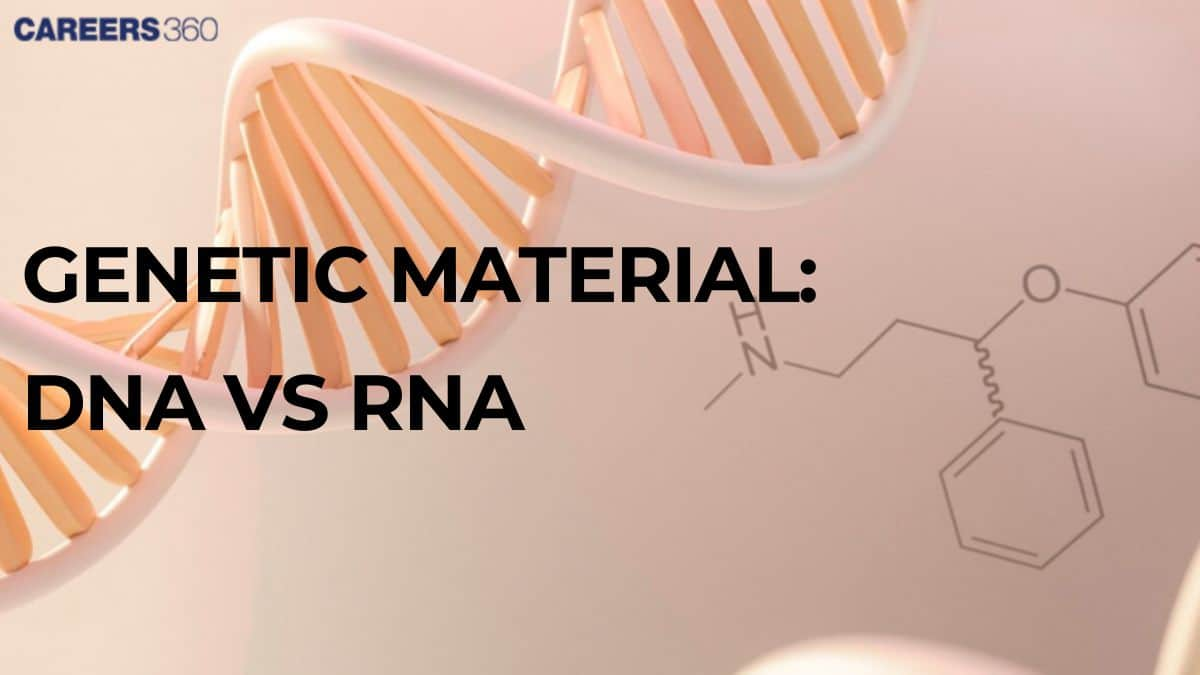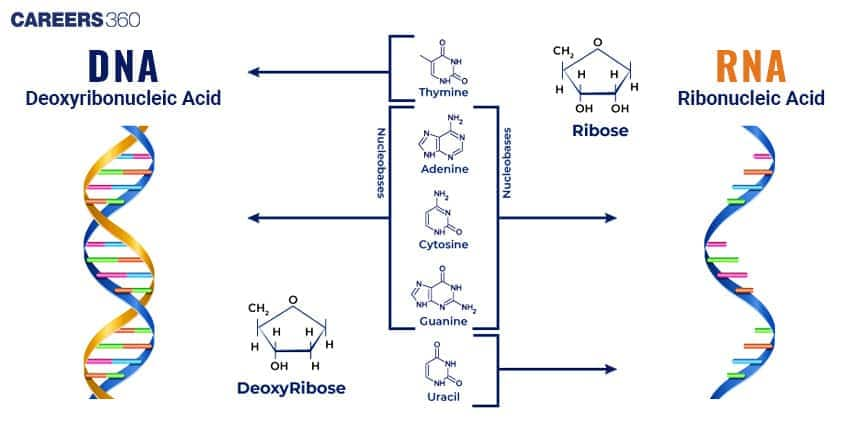Genetic Material- DNA vs RNA: Definition & Function
Genetic material is the hereditary substance of the organism. It carries all information which is specific to the organism. It is known as DNA or RNA. In prokaryotes such as bacteria, the DNA is found in the cytoplasm. In eukaryotes such as plants and animals, DNA is found in the nucleus of the cell.
- What is Genetic Material?
- DNA as Genetic Material
- RNA as Genetic Material
- Key Differences between DNA and RNA
- MCQs on Genetic Material: DNA vs RNA

DNA is also found extranuclearly such as mitochondria and chloroplasts have their own DNA. The genetic material helps control the organism’s composition. The material is identical in the somatic cells of the multicellular organism. The genetic material can replicate within the cell, so new cells have the same genetic material as the parent cell. Genetic Material: DNA vs RNA is a topic of the chapter Molecular Basis of Inheritance in Biology.
What is Genetic Material?
Genetic material is the basic foundation of biological components, or it stores, transmits and carries out the level of genetic information or the pathways that pave the way for growth, development and survival. In biological systems, genetic material is present in two basic forms: Deoxyribonucleic Acid (DNA) and Ribonucleic Acid (RNA).
DNA as Genetic Material
Deoxyribonucleic Acid is the full form of DNA. It is the genetic blueprint for the development and functioning of all living things. In 1953, James Watson and Francis Crick described the features of the double-helix structure of DNA.
DNA stands for Deoxyribonucleic acid, a long double-helix molecule composed of nucleotides. A nucleotide is made of a phosphate group, a deoxyribose sugar (forming the sides of the ladder), and one of four nitrogenous bases: adenine (A), thymine (T), cytosine (C), and guanine (G)—purines paired with pyrimidines. This complementary base pairing and, hence, it is very critical for the processes of replication of DNA and DNA repair.
The hydrogen bonds between the bases and the hydrophobic interactions among the stacked bases stabilize the double helix. Two strands of DNA are paired in a manner that allows genetic information to be stored in a relatively small space. This proves the fact that every DNA strand can serve as a template for the formation of a new complementary strand in a manner that conveys genetic information correctly during cell division.
RNA as Genetic Material
Ribonucleic Acid, or RNA, is a single-stranded nucleic acid molecule that also codes, transcribes, regulates, and expresses genes. The only difference is while encoding and translating genes, ribonucleic acid works together with other molecules of the cell to carry out the function of producing proteins.
RNA consists of nucleotides containing a ribose sugar, a phosphate group, and one of four nitrogenous bases: adenine, uracil, cytosine, and guanine. The presence of the hydroxyl group on the ribose sugar makes RNA less stable than DNA. Therefore, it is common for RNAs to be single-stranded and less stable than DNAs.
RNA can be folded to form complex three-dimensional structures and, therefore, can perform many structural and catalytic functions in the cell. The fact that RNA is single-stranded has many consequences, including its ability to form secondary structures like hairpins and loops; these features are crucial for the functioning of RNA in the synthesis and regulation of proteins.
Key Differences between DNA and RNA
There are quite some differences between DNA and RNA, at various levels such as chemically, structurally and also on a functional basis. The differences are also tabulated below.
Chemical Differences: DNA contains deoxyribose sugar, while RNA has ribose sugar. DNA contains thymine (T) as a base, while RNA contains uracil (U).
Structural Differences: DNA as a double-stranded molecule forms a stable double helix structure, while RNA is mostly single-stranded, though it may fold into diverse 3D forms.
Functional Differences: DNA is, therefore, a substituent of the genetic information an organism possesses- and the taker of this to the next generation. RNA, being an intermediary in the function, does the actual synthesis directly for the protein and other cellular operations.
It is one of the important differences and comparisons articles in Biology. The differences between DNA and RNA are given below-
Feature | DNA | RNA |
Sugar | Deoxyribose | Ribose |
Structure | Double-stranded helix | Single-stranded |
Stability | More stable | Less stable |
Bases | Adenine, Thymine, Cytosine, Guanine | Adenine, Uracil, Cytosine, Guanine |
Function | Long-term storage of genetic information | Protein synthesis and other functions |
Diagram: DNA vs RNA
Below is the diagram showing the difference between DNA and RNA.

MCQs on Genetic Material: DNA vs RNA
Q1. A molecule that can act as a genetic material must fulfil the traits given below, except
Option 1: It should be able to express itself in the form of 'Mendelian characters'
Option 2: It should be able to generate its replica
Option 3: It should be unstable structurally and chemically
Option 4: It should provide the scope for slow changes that are required for evolution
Correct answer: 3) It should be unstable structurally and chemically
Explanation:
Characteristics of Genetic Material -
1) It should be able to replicate.
2)Stable
3) Provide scope for mutations that are required for evolution.
4) Should be able to express itself in the form of (Mendelian Character)
Therefore, an unstable molecule cannot serve as genetic material.
Hence, the correct option is 3) It should be unstable structurally and chemically
Q2. Given below are two statements:
Statement 1: In the RNA world, RNA is considered the first genetic material to evolve to carry out essential life processes. RNA acts as a genetic material and also as a catalyst for some important biochemical reactions in living systems. Being reactive, RNA is unstable.
Statement II: DNA evolved from RNA and is a more stable genetic material. Its double helical strands being complementary, it resists changes by evolving a repairing mechanism. In light of the above statements, choose the most appropriate answer from the options given below:
Option 1: Statement I is incorrect, but Statement II is correct
Option 2: Both statements I and II are correct
Option 3: Both statements I and II are incorrect
Option 4: Statement I is correct, but Statement II is incorrect
Correct answer: 2) Both statements I and II are correct.
Explanation:
RNA is thought to be the first genetic material since it has the dual ability of functioning as a catalyst (ribozyme) as well as a genetic material. But due to its high reactivity, it does not store for the long term and can degrade under cellular conditions.
DNA later appeared, and it is chemically more stable. It has a double-stranded arrangement with complementary pairing of bases, which allows correction of errors and also repairing, and that makes it more reliable long-term genetic material that guarantees perfect transmission of genetic information across several generations in more evolved and complex forms of life.
Hence, the correct answer is option 2) Both statements I and II are correct.
Q3. Which of the following properties of the genetic material was not proposed by Linus Pauling, but was later discovered to be a key characteristic of DNA?
Option 1: Composed of repeating nucleotide units
Option 2: Has a helical structure
Option 3: Exhibits base pairing specificity
Option 4: Possesses phosphate groups in its backbone
Correct answer: 3) Exhibits base pairing specificity
Explanation:
Although Linus Pauling made important contributions to the study of DNA, he did not propose the concept of base pairing specificity, which was later discovered by Erwin Chargaff. Chargaff observed that the amounts of adenine (A) and thymine (T) and the amounts of guanine (G) and cytosine (C) in DNA were equal.
Hence, the correct answer is option 3) Exhibits base pairing specificity
Also Read-
Frequently Asked Questions (FAQs)
DNA is double-stranded with deoxyribose sugar and thymine, while RNA is single-stranded with ribose sugar and uracil.
RNA transcribes genetic information from DNA (mRNA), translates it into proteins (tRNA), and forms part of the ribosome structure (rRNA).
DNA's double-helix structure and lack of a hydroxyl group on the sugar make it more stable than RNA, which is single-stranded and more prone to degradation.
DNA is more stable because its double-stranded structure provides better protection against damage. The deoxyribose sugar in DNA is also less reactive than the ribose in RNA, making DNA less prone to hydrolysis.
mRNA carries genetic information, tRNA brings amino acids for protein synthesis, and rRNA forms the core of ribosomes and catalyzes protein synthesis.
DNA provides the genetic blueprint, which is transcribed into mRNA, and then translated into proteins by tRNA and rRNA in the ribosome.
Also Read
06 Aug'25 01:27 AM
26 Jul'25 01:17 PM
26 Jul'25 01:05 PM
26 Jul'25 12:30 PM
26 Jul'25 12:08 PM
25 Jul'25 06:40 PM
25 Jul'25 01:12 PM
25 Jul'25 01:04 PM
